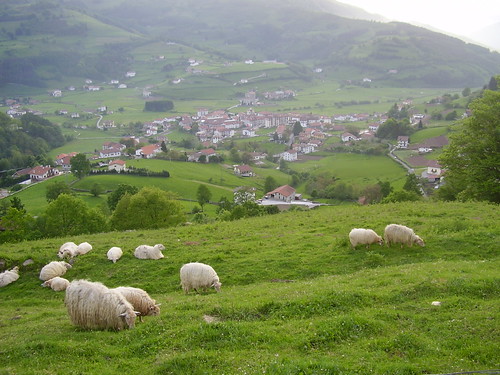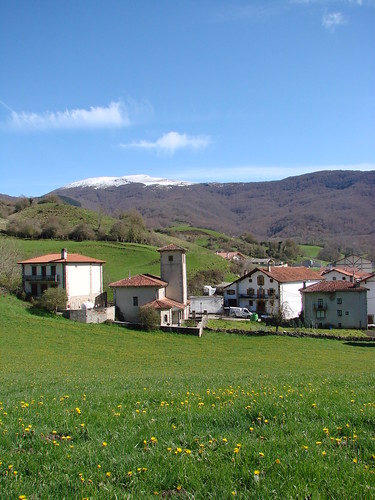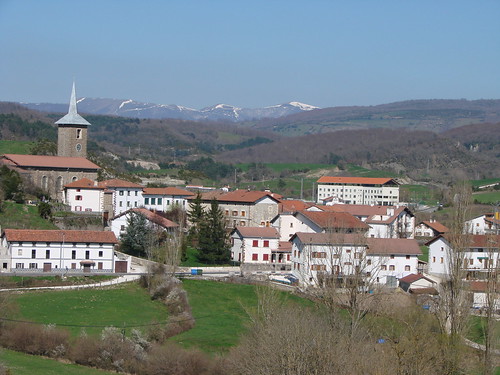
On the western edge of the territory of the Pyrenees Tourist Consortium Navarro is the route between Pamplona / Iruñea to St. Jean Pied de Port / Saint Jean-Garazi. Are valleys that make up the Camino de Santiago (if we do it from north to south) or Ultrapuertos (if going from south to north).
Quinto Real and Sorogain:
Quinto Real is a beautiful place crossed by a multitude of races. Crossed from north to south by the River Arga, this vast forest inhabited by a large number of animal species. It houses the ruins of the Royal Arms Factory Eugi and is itself a fascinating space.
Fifth Royal belongs to the valleys of Erro, Baztan, Esteribar and Alduides. It abounds in deer, roe deer and fallow deer and wild boars and foxes. The birds complement the enormous wealth of fauna of this lush forest. Prominent among them the black woodpecker, the white-backed woodpecker and woodcock, on par with large prey such as eagle, honey buzzard and scavengers such as vultures or the bearded vulture.

The bellow is in autumn, the most important event of the forest. This is the time when the male deer seeking a female to mate with in order to preserve the species. Her wails and chants, a prelude to the struggle for supremacy, spread throughout the forest.
From Quinto Real Baztan can be accessed through the port of Artesiaga, or for that of Urkiaga Alduides.
Sorogain (Valle de Erro) is a splendid environment for relaxation, to give gentle walks or climbing a mountain of easy ascent. It is a magnificent spot where it seems that time has stopped, a vast green carpet surrounded by beeches, oaks and mountains. In the background, the majestic Adi seems to play the watchdog role of eternal paradise where the lush green forest, meadow and river form an unforgettable landscape. Sorogain hosts won the Valleys of Erro and under the faceria Baigorri, leading to a big party on the occasion of marking the same. The entire area of grasses found several stations dolmens, the remains of a pastoral past in prehistory. Sorogain has a recreation area, in an environment of great beauty conditioning with tables, benches and stone grills.
Eugi Reservoir:
Eugi Reservoir lies at the feet of the people of the same name, forming a magnificent enclave. It lies in the headwaters of the river Arga near the beautiful forest of Quinto Real. Opened in 1971, has a capacity of 21 hm 3 and was built to supply water to Pamplona / Iruñea and its region. The beauty of its surroundings and proximity to the beech make it advisable to visit.

Aezkoa and Orozco Betelu:
Valley Betelu Aezkoa and Orozco have a rich natural and cultural heritage, often unknown. The Forest of Iratí is the best known example of its vast and luxuriant forests, habitat of countless species. The Arms Factory Orbaizeta, granaries, dolmens, shrines, trails … are among the hallmarks of a land and establishment of its people. Come and enjoy the scenery, natural and human, dotted with bits of history.
Weapons Factory:
The remains of the Orbaizeta Arms Factory, a real gem of industrial archeology s XVIII, are a good excuse to explore a time and a worldview. The Factory was actually a village, a small town in the Pyrenees of Iratí beech.
He had church and palace in the center space and different types of housing in terms of social class. His inspiration illustrated (S XVIII) resulted in concern for the comfort of workers, reversing the good of the production. With more than 50 workers, skilled workers and technicians, the operating and maintenance expense was enormous, but came to make 3600 bombs per year.
Factory Orbaitzeta weapons arose when the existing forests depleted Eugi around. He then sought another place where, sustainably, it could ensure a continuous production that would meet the demand of the artillery corps of the royal army.
The proximity of iron deposits traditionally exploited the abundance of water in nearby creeks and timber (Mount Aezkoa was ceded by a pact which was later breached by the Crown) Carlos III encouraged installing the factory where we know it today. Previously cited the existence of a foundry in Txangoa, north of where today are the ruins of the factory, a term that refers to such activity ferrera: Olazar.

Almost all major wars of the s. Century greatly affected the factory and all peoples of the Valley: the war of the Convention, the Carlist wars, etc..
Since its decommissioning in 1873 the factory complex has been gradually deteriorating. Nevertheless, they still appreciate some dependencies: furnaces, Legartza river channelization, churches, palaces, etc. There is now a restoration project which aims to restore the factory look befitting their importance.
There is much more to be done and we will return…The Navarrese Pyrenees
Leave a Reply
You must be logged in to post a comment.
Recent Comments